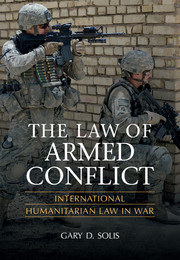Book contents
- Frontmatter
- Contents
- Table of Cases
- Table of Treaties
- Foreword
- Preface
- Acknowledgments
- LAW OF ARMED CONFLICT: INTERNATIONAL HUMANITARIAN LAW IN WAR
- LAW OF ARMED CONFLICT AND INTERNATIONAL HUMANITARIAN LAW: A FRAMEWORK
- 5 Conflict Status
- 6 Individual Battlefield Status
- 7 Law of Armed Conflict's Four Core Principles
- 8 What Is a “War Crime”?
- LAW OF ARMED CONFLICT AND INTERNATIONAL HUMANITARIAN LAW: BATTLEFIELD ISSUES
- References
- Index
- References
5 - Conflict Status
from LAW OF ARMED CONFLICT AND INTERNATIONAL HUMANITARIAN LAW: A FRAMEWORK
- Frontmatter
- Contents
- Table of Cases
- Table of Treaties
- Foreword
- Preface
- Acknowledgments
- LAW OF ARMED CONFLICT: INTERNATIONAL HUMANITARIAN LAW IN WAR
- LAW OF ARMED CONFLICT AND INTERNATIONAL HUMANITARIAN LAW: A FRAMEWORK
- 5 Conflict Status
- 6 Individual Battlefield Status
- 7 Law of Armed Conflict's Four Core Principles
- 8 What Is a “War Crime”?
- LAW OF ARMED CONFLICT AND INTERNATIONAL HUMANITARIAN LAW: BATTLEFIELD ISSUES
- References
- Index
- References
Summary
Introduction
On a most basic level, essentials of the law of armed conflict/international humanitarian law (LOAC/IHL) are 1907 Hague Regulation IV, the four 1949 Geneva Conventions, and 1977 Additional Protocols I and II. In what circumstances do they apply, and how do they interact? In a given case, do they all apply, do they apply only in part, or do they apply at all?
Now we can resolve those questions, as well as the first of the two questions a law-of-war student should always be prepared to answer: What is the conflict status? (The second foundational question, addressed in the next chapter, is: What is the status of the individuals involved in the conflict?) In determining conflict status, one asks what law of war, if any, applies in the armed conflict under consideration?
It is not always an obvious determination. “The problem is that the Geneva Conventions do not provide an authoritative definition of ‘armed conflict.’ Substantial evidence suggests, in fact, that the drafters of the Conventions purposely avoided any rigid formulation that might limit the applicability of the treaties.” As in many matters of law, there is no “bright line test,” no formula to determine whether there is an armed conflict in progress, let alone what LOAC/IHL may apply. With an understanding of the basics, and a modest tolerance for ambiguity, one can make a sound assessment.
- Type
- Chapter
- Information
- The Law of Armed ConflictInternational Humanitarian Law in War, pp. 149 - 185Publisher: Cambridge University PressPrint publication year: 2010



